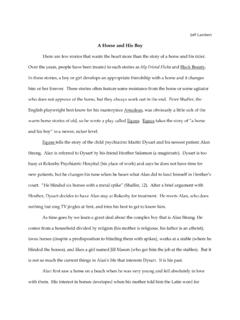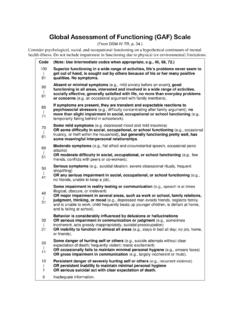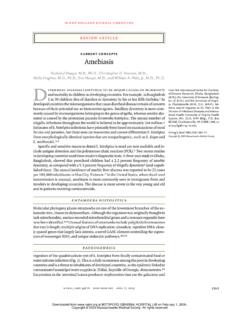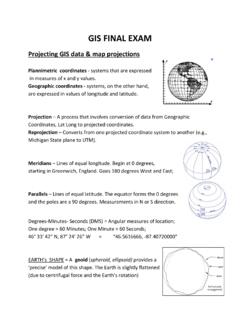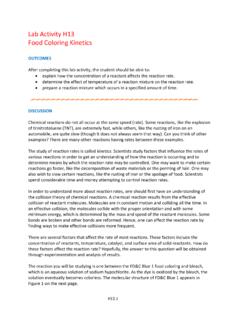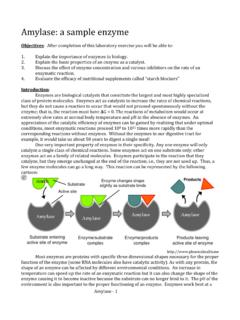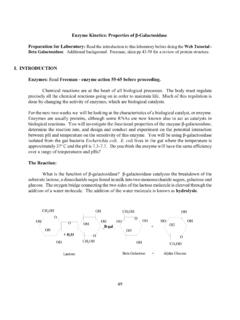Transcription of Enzymes: Amylase Activity in Starch-degrading Soil Isolates
1 enzymes : Amylase Activity in Starch-degrading Soil IsolatesIntroductionThis week you will continue our theme of industrial microbiologist by characterizing how differingreaction conditions affect enzyme reaction rates of the Amylase produced by your starch degradingisolates from last week. Even though they represent a rich source of energy for microorganisms (andus!), starch molecules are much too large to get into the cell. To overcome this and take advantage ofthis potential energy source, cells secrete Amylase into the environment. The Amylase breaks the starchinto smaller, disaccharide, maltose molecules that can then be easily transported into the cell.
2 Becauseamylase is an extra-cellular protein, we can grow starch degraders in broth culture, remove the cellmass by centrifugation and then simply use the resulting supernatant broth containing the extra-cellularenzyme to characterize our Amylase without need for further purification (which we will also do laterin the semester).Learning ObjectivesYou should:Conceptual understand that enzymes are protein catalysts necessary for cellular function. understand that environmental (and cytoplasmic) conditions (temperature, pH, etc.) affectenzyme performance understand how and why that performance is affectedPractical gain experience in experimental design gain experience at mixing reaction cocktails gain experience running a colorometric assay and the use of standard curves in analyzing dataUnderlying ScienceAmylases are a family of enzymes that degrade starch (polymers of glucose) into smaller disaccharides(maltose).
3 A molecule of water is also split during this reaction and the OH- and H+ ions bind to theexposed ends of the broken starch polymer. This type of reaction is called hydrolysis (water splitting).Hydrolysis is a common mechanism used by enzymes to break chemical hydrolysis of starch can be measured through the use of an enzyme test or assay. An enzyme assaywill test for the simple presence of enzyme Activity but can also be used to measure the reaction rate ofan enzyme-catalyzed reaction. The assay can measure either the appearance of one of the products orthe disappearance of one of the substrates over measure your Amylase Activity , you will monitor the disappearance of Amylase s substrate, reacts with iodine (which is yellow) to form a blue compound (Amax 620 nm).
4 This reaction isthe basis of a colorimetric assay for Amylase Activity . Broth culture supernatant (which contains thesecreted Amylase ) will be incubated with starch . After the incubation period, a portion (an aliquot) ofthis mixture is combined with acidic iodine. The acid stops the enzymatic reaction and the iodinereacts with the starch to produce the blue color. Any starch that has not yet been hydrolyzed by theamylase will turn blue, with the intensity of the blue color being proportional to the amount of starchremaining. The intensity of the blue color can be quantified spectrophotometrically by measuring itsabsorbance at 620 nm.
5 The greater the change in absorbance between a sample containing the initialamount of starch (without enzyme) and the hydrolyzed mixture containing the enzyme, the greater theamount of starch degraded by the enzyme, therefore the greater the Activity of the enzyme Activity (reaction rates ) is dependent upon the environmental conditions either in nature or inthe laboratory ( temperature, pH, etc.). This is because these conditions can alter the amino acidside chains in a protein, affecting protein structure and folding and sometimes the enzyme's active effects of some of those conditions will be explored in this as in any chemical reaction, the concentration of reactants (substrates) will affect enzymaticreaction rates .
6 In regards to substrate concentration, enzyme kinetics follow the Michaelis-MentonModel:Vo = Vmax x [s]/Km + [s]Where: Km = Michaelis constant[s] = substrate concentrationThis will be discussed in detail in concentration [S]Maximal velocity (Vmax)D Abs /ml (enzyme Activity or velocity)KmVmax/2 ExercisesPart A. Determination of Amylase Activity in microbial isolatesSince your Isolates secrete Amylase outside of the cell, we will assay the supernatant of centrufugedbroth cultures of your Isolates for Amylase Activity . You must come in the day before your section meetsto start cultures of your Isolates .
7 We will have 37oC and 50oC waterbaths ready for culture tubes containing 5 ml of LB broth for growing your isolates1 tube of LB broth to use for your "I" tubesMicropipettors and tipsPhosphate buffer, pH 7 (200 mM phosphate) starch solution ( w/v)Acidic iodine solution5 ml pipetsVortexSpectrophotometer and cuvettesTest tubesTest tube racks2ml microcentrifuge tubesProtocolPart A. Determination of Amylase Activity from microbial isolates1.) The day before your section meets you must come in to inoculate LB broth tubes with your Starch-degrading Isolates . Use an inoculating loop to inoculate the tubes and incubate the appropriateisolate overnight in the 37 C or 50 C shaking ) Using a P-1000 micropipettor, transfer 1500 ml of each isolate to 2 ml microcentrifuge tubes.
8 Labelthe tubes with your team number and "37" for the 37oC isolate and "50"for the 50oC isolate andspin them in the microcentrifuge at 10,000 RPM for 5 minutes to pellet the bacterial ) While your tubes are spinning, turn on your spectrophotometers to warm up. When they arewarmed up, set the wavelength at 620 ) Gently pipet the supernatant (containing the Amylase ) to a fresh microcentrifuge tube withoutdisturbing the pellet (don't worry about leaving some of the supernatant behind). Put thesupernatants on ice and dispose of the cell pellets in the orange biohazard bags ("kill buckets" in"Urbance-speak").
9 5.) Obtain three clean test tubes and label them I (for initial), "37" and "50".6.) Use a P1000 to add 500 l of pH 7 buffer to each tube; this buffer will keep the pH constant duringthe ) Add 500 l of starch solution to each tube -- Mix by vortexing gently. It is important that each tubehas exactly the same amount of starch solution since starch is the substrate for the reaction and theinitial amount of starch affects the blue color ultimately formed when you add the iodine (step 10below). Pipet ) To the "I" tube, add 100 ml of distilled ) Add 100 ml of the 37oC supernatant to the tube labeled "37".
10 Quickly vortex and note the time(time=0).10.) Time your reaction carefully and after exactly 5 min add 500 ml of iodine solution-- thesolutions will turn blue from the starch -iodine ) Quickly add ml of water to the 37 tube to stop (slow) the reaction and get the color to anOD between and 1 (linear range for the spectrophotometer).12.) Use a blank tube consisting of ml of buffer, ml of starch solution and ml of water tozero the spectrophotometer at 620 ) Immediately read the I and 37 tubes in the spectrophotometer at 620 nm. Record your are measuring the enzyme rate of the Amylase in your supernatant.

